The beach, the sea atrium
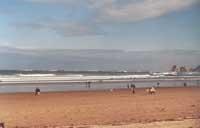
The sandy and gravel beaches that we connect with the sun and leisure are living communities, inhabited by different plants and animals. The combination of conditions produced by the interaction between sea and land constitutes the specific characteristics for the creation of these ecosystems. Large changes occur in these accumulators in a short time.
Active sedimentary processes occur continuously on natural beaches, and in these processes various factors intervene: seasonal cycles, relative sea level variations, sediment provisions, weather cycles, etc.
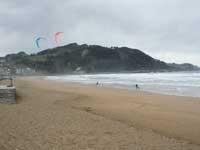
The collaboration of all these factors gives rise to unique geological and geomorphological conditions, under which the main physical characteristics of the place are established: grain size, slope, sedimentary structures, etc.
The beach is built by sediments. They can come from erosion of marine and coastal rocks, deposits of rock generated in landfalls, eroded materials and transported by rivers, etc.
Once immersed in the beach system, these currents or waves drag these materials to the coast, off the coast or parallel to the coast. These forces round and polish the rocks. The effects of the tide and the waves release, reduce and mix the particles until the size of the sand.
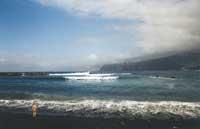
Sediments accumulate and erode cyclically and the beach is in a constructive or erosive phase depending on the predominance of each moment. The balance between these two phases defines the evolution of the beach.
Normally accumulation predominates in some times and erosion in others. If they are in long-term balance, the extent of the beach does not vary. However, if one of them predominates, the beach is transformed. Often the human being performs activities that affect the dynamics of the beach, giving more strength to one of these two phases. This causes imbalance and alteration of the beaches.
Influence of the sea
Defines the character of the beach by its relationship with the sea. Thus, the physical areas of the beach are distributed according to the influence of tides, each of which has specific sets of conditions for living beings.
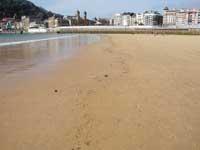
The submarine zone is defined by the low tide line and the limit of movement of sediments by water break. It is usually formed by one or more sand bars, forming intermediate depressions, all parallel to the coast. The area is of great energy.
The front or front of the beach is submerged and periodically discovered by the tides. It is the active beach area, where the biggest changes occur throughout the day. The inclination towards the sea is usually quite inclined, especially in the highest part. The surface is relatively smooth due to the action of the waves and at the top is the top of the beach.
At the back of the top of the beach the slope towards the sea is softer. It is located above the top water line and only supports the action of waves when there are live tides. It extends from the fold point to the upper limit of influence of storm waves. It has a hard surface and, among storms, develops forms created by the wind.
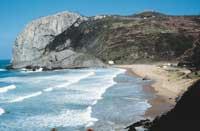
The drift line shows the upper boundary of the sea. This line is defined by the materials further away from the surf, so water does not act directly.
Many beaches have their inner limit on cliffs or dunes. These cliffs are often inactive, as they usually do not suffer from sea attack.
For the development of the dunes, the sediment must be sand sized. These particles are transported and modeled by the wind and sand accumulates above the drift line.
When acting on the dynamics of the beach system, the natural structure is transformed. For example, limiting the energy of the waves for reasons of human interest, altering the riverbeds or altering the coast can make disappear the extraordinary characteristics of these rich natural spaces. The same effect can have the overexploitation of these areas.
Beaches of the Basque coast
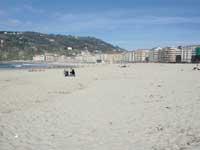
On the Basque coast, especially in the west, hard rocks predominate and beaches appear between the cliffs. However, as they head northeast, they have more and more room to expand. There are many small beaches a few meters long, but there are also others that extend over a kilometer.
The beaches of the Bay of Biscay are both sandy and gravel. Many of them are open to the sea, some totally outdoors and others in corners. Most of these beaches are narrow, as they are often bounded by a cliff. Examples of this are the beaches of Sopelana and those of Azkorri.
On the other hand, most of the main beaches are located in the rías. The interaction between the river and the sea is of great importance. In this type of area are the longest in Euskal Herria, such as Hendaia and Zarautz. In all the rías of Lapurdi, Gipuzkoa and Bizkaia there have been natural beaches, although sometimes they have disappeared.
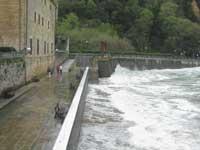
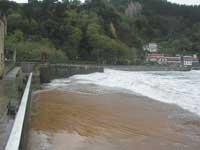
We also find them in bays, although they are few in Euskal Herria. The best known is that of Donostia-San Sebastian, a good place for storage, since in the erosive phase they have little energy.
In San Sebastian there was also a tombolo, but on it was built and completely covered. Another example of such structures still exists in Lekeitio, but it has also suffered some human influence.
Due to the relief of the Basque Country, the population is concentrated in the river valleys, as well as in the coasts and rías. Therefore, industrial development has occurred in river basins and in most rías. In addition, the activity of the workshops and the population extends from the rivers to the coast.
This has had a great influence on the coast, disappearing in recent years elements of different beaches or entire beaches. Examples of this are those of the Nervión estuary. Sometimes the activity that has caused it has taken place on the beaches themselves, but on other occasions the affection to the interior and coastal elements has directly affected the beaches. For example, the construction of dikes or the transformation of rivers have drastically altered the dynamics of beaches such as Gorliz or Gros.
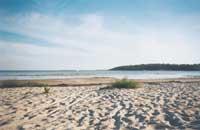
Currently there are fully artificial beaches on the Basque coast, such as Hondarribia. They have been given their characteristics for leisure and often have to bring sand periodically to the beach of Angelu. In fact, many artificial beaches are not located in areas of accumulation and suffer constant erosion.
Coast, energy and sedimentary cocktail
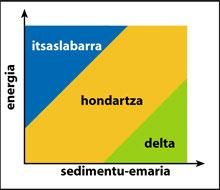
The coasts are of great importance worldwide, as coastal areas have always attracted people. The settlements were located in places easier to embark, in order to facilitate their livelihood. In addition, leisure attracts more and more people to the coast and, above all, to the beaches.
The creation of these spaces requires specific conditions. In fact, the coast is physically very complex. The action of the waves, the distribution of energy and the flow of sediments, among others, define the development of the coast. For example, when sediment flow is similar to energy, sediments normally accumulate and beaches are created.
Wide variety of sizes, shapes and types
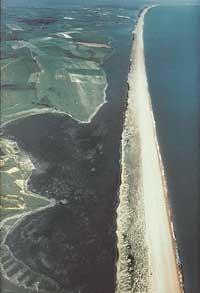
The beaches have different characteristics depending on the climate and geographical environment. In addition, its location on the coast also makes them one way or another, which is taken into account in most of the rankings made.
Those located on the same coast: of bays, at the foot of cliffs, of rías… They can be direct, concave or convex.
Barrier beaches are separated from the coast by a swamp or lagon.
The coastal reeds, attached on one side to the edge of the terrain, penetrate the sea.
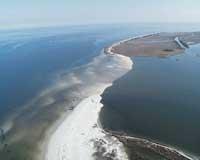
Tombolos are beaches that connect an island or rock with the coast. Sometimes the pleamari cover them, but the low tide reappears.
The material of the beach also has great influence on the appearance of the beach. Quartz, for example, has a great presence on many sandy beaches, as it resists erosion very much. This mineral gives a light color to the beach. Next to this you can find fragments of shells, fragments of stones, etc.
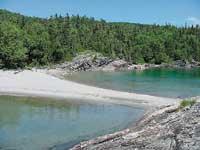
In other places, corals and lava are some of the main components of the sand, as on the beach erodes and stores the material available in each area. The color of the sand depends on the composition: brown, white, black, green, pink…
Buletina
Bidali zure helbide elektronikoa eta jaso asteroko buletina zure sarrera-ontzian











